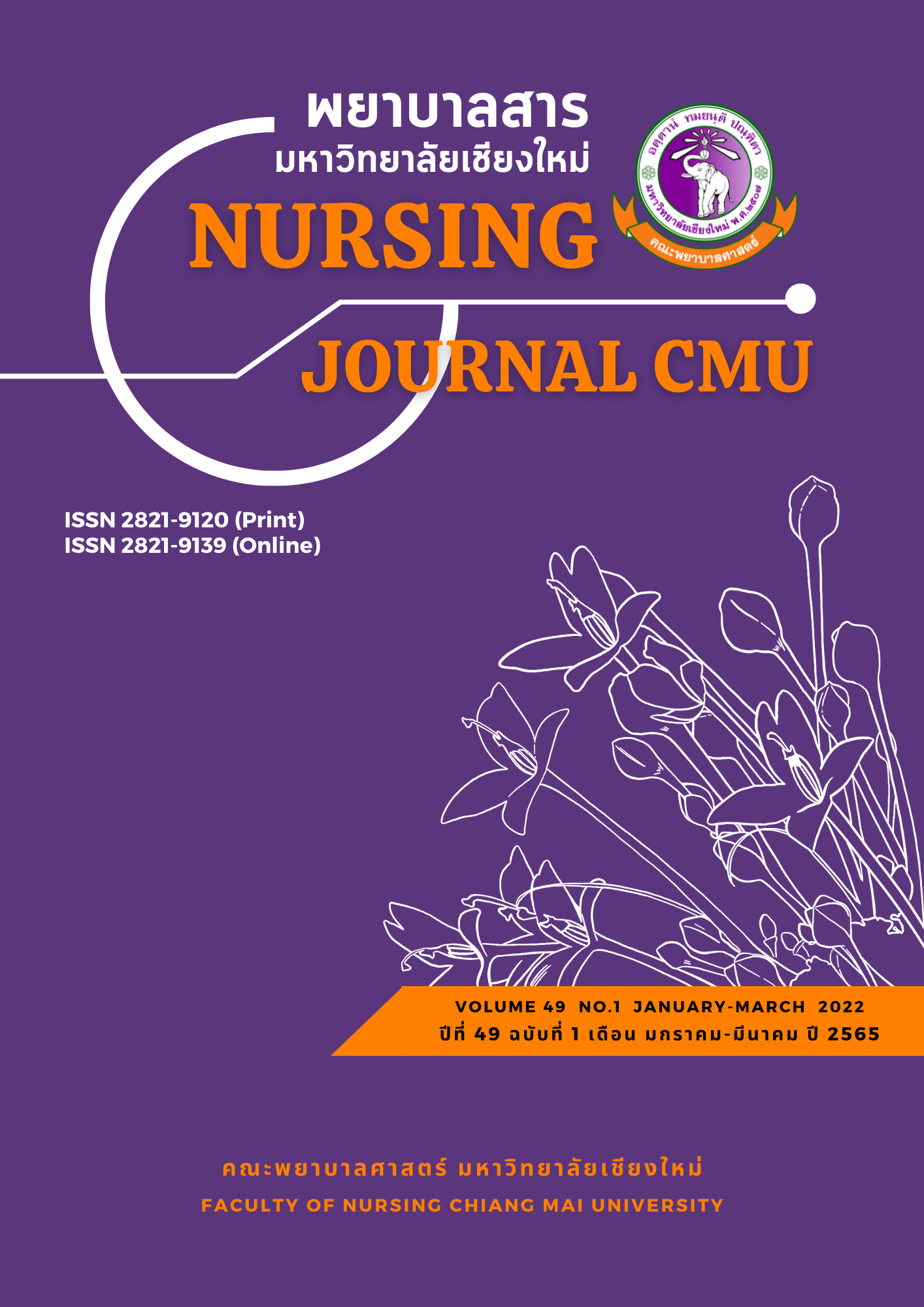Factors Related to Intention of Near Miss Reporting of Nurses, Northern Regional Hospitals
Keywords:
Intention, Near Miss Reporting, Nurses, Northern RegionalAbstract
Reporting near-miss accidents can help nurses correct causes and prevent future adverse events. This descriptive correlational research studied nurse intentions in reporting near misses in northern Thai regional hospitals and the factors related to their intentions. Participants included 438 nurses. Study instruments were the Attitude Scale, the Subjective Norm Scale, the Perceived Control Scale, and the Scale of Nurses’ Intention to Report Near Misses, all developed by the researcher. The Cronbach’s alpha coefficients for these scales were .96, .90, .90, and .97, respectively. Data were analyzed using descriptive statistics and Spearman’s correlation coefficient.
Results were as follows:
1. Approximately 56 percent of nurses had high levels of intention to report, 40 percent had moderate levels, and 4 percent had low levels.
2. Attitudes, subjective norms, and perceived control were positively related to intention to report (rs=.29, p=.001, rs=.48, p=.001, rs=.19, p=.001).
Results suggest that nurse managers should encourage nurses to report near miss accidents by developing convenient and non-punitive reporting systems. Further study is recommended to develop an intervention based on theory of planned behavior to boost such reporting.
References
American Cancer Society. (2019). Breast cancer facts & figures 2019-2020. Retrieved from https://www.cancer.org/content/dam/cancer-org/research/cancer-facts-and-statistics/breast-cancer-facts-and-figures/breast-cancer-facts-and-figures-2019-2020
Andrea K. M. (2017). Cost of breast cancer burdensome for many patients. Retrieved from https://www.baltimoresun.com/health/bs-hs-breast-cancer-cost-20171024-story.html
Brady, M. J., Cella, D. F., Mo, F., Bonomi, A. E., Tulsky, D. S., Lloyd, S. R., Shiomoto, G. (1997). Reliability and validity of the functional assessment of cancer therapy-breast quality-of-life instrument. Journal of Clinical Oncology: Official Journal of the American Society of Clinical Oncology, 15(3), 974-986.
Bray, F., Ferlay, J., Soerjomataram, I., Siegel, R. L., Torre, L. A., Jemal, A. (2018), Global cancer statistics 2018: GLOBOCAN estimates of incidence and mortality worldwide for 36 cancers in 185 countries.CA: A Cancer Journal for Clinicians, 68(6), 394-424.
Cella, D. F. (1992). Quality of life: The concept. Journal of Palliative Care, 8(3), 8-13.
Cotton, S. P., Levine, E. G., Fitzpatrick, C. M., Dold, K. H., & Targ, E. (1999). Exploring the relationships among spiritual well-being, quality of life, and psychological adjustment in women with breast cancer. Psycho-Oncology, 8(5), 429-438.
Eremenco, S., Cella, D., & Arnold, B. J. (2005). A comprehensive method for the translation and cross-cultural validation of health status questionnaires, Evaluation & the Health Professions, 28(2), 212-232. doi: 10.1177/0163278705275342
Farthmann, J., Hanjalic-Beck, A., Veit, J., Rautenberg, B., Stickeler, E., Erbes, T., Hasenburg, A. (2016). The impact of chemotherapy for breast cancer on sexual function and health-related quality of life. Support Care Cancer, 24(6), 2603-2609.
Ferlay, J., Soerjomataram, I., Dikshit, R., Eser, S., Mathers, C., Rebelo, M., … Bray, F. (2015). Cancer incidence and mortality worldwide: Sources, methods and major patterns in GLOBOCAN 2012. International Journal of Cancer,136(5), E359-86. doi: 10.1002/ijc.29210
Folkman, S. (1982). An approach to the measurement of coping. Journal of Occupational Behavior, 3, 95-107.
Greer, S., & Watson, M. (1987). Mental adjustment to cancer: Its measurement and prognostic importance. Cancer Surveys, 6(3), 439-453.
Kamińska, M., Ciszewski, T., Kukiełka-Budny, B., Kubiatowski, T., Baczewska, B., Makara-Studzińska, M., & Bojar, I. (2015). Life quality of women with breast cancer after mastectomy or breast conserving therapy treated with adjuvant chemotherapy. Annals of Agricultural and Environmental Medicine, 22(4), 724-730.
Kugbey, N., Meyer-Weitz, A., & Oppong Asante, K. (2019). Mental adjustment to cancer and quality of life among women living with breast cancer in Ghana. International Journal of Psychiatry in Medicine, 54(3), 217-230.
Lauriola, M., & Tomai, M. (2019). Biopsychosocial correlates of adjustment to cancer during chemotherapy: The key role of health-related quality of life. The Scientific World Journal. 1-12.doi.org/10.1155/2019/9750940
Lôbo, S. A., Fernandes, A. F. C., Almeida, P. C. D., Carvalho, C. M. D. L., & Sawada, N. O. (2014). Qualidade de vida em mulheres com neoplasias de mama em quimioterapia. Acta Paulista de Enfermagem, 27, 554-559.
National Comprehensive Cancer Network. (2019). NCCN guidelines for treatment of breast cancer. Retrieved from https://www.nccn.org/professionals/physician_gls/ default.aspx
Patoo, M., Allahyari, A., Moradi, A.-R., Payandeh, M., & Hassani, L. (2017). Studying the relation between mental adjustment to cancer and health-related quality of life in breast cancer patients. International Journal of Cancer Management, 11(7), e8407.
Pereira, F., & Santos, C. (2016). Psychological adaptation and its impact on the quality of life and spiritual well-being: A cross-sectional study of end of life cancer patients. Nursing and Palliative Care, 1. doi: 10.15761/NPC1000126
Sung, H., Ferlay, J., Siegel, R. L., Laversanne, M., Soerjomataram, I., Jemal, A., & Bray, F. (2021). Global cancer statistics 2020: GLOBOCAN estimates of incidence and mortality worldwide for 36 cancers in 185 countries. CA: A Cancer Journal for Clinicians, 71(3), 209–249.
Trieu, P. D., Mello-Thoms, C., & Brennan, P. C. (2015). Female breast cancer in Vietnam: A comparison across Asian specific regions. Cancer Biology Medicine, 12(3), 238-245.
Watson, M., Greer, S., Young, J., Inayat, Q., Burgess, C., & Robertson, B. (1988). Development of a questionnaire measure of adjustment to cancer: The MAC scale. Psychological Medicine, 18(1), 203-209.
Watson, M., Law, M. G., Santos, M. D., Greer, S., Baruch, J., & Bliss, J. (1994). The Mini-MAC. Journal of Psychosocial Oncology, 12(3), 33-46.
Yamane, T. (1973) Statistics: An introductory analysis (3rd ed). New York: Harper and Row.
Zanuso, V., Fregoni, V., & Gervaso, L. (2020). Side effects of adjuvant chemotherapy and their impact on outcome in elderly breast cancer patients: A cohort study. Future Science OA, 6(9), FSO617. doi: 10.2144/fsoa-2020-0076
Downloads
Published
How to Cite
Issue
Section
License
Copyright (c) 2021 Nursing Journal

This work is licensed under a Creative Commons Attribution-NonCommercial-NoDerivatives 4.0 International License.
บทความที่ได้รับการตีพิมพ์เป็นลิขสิทธิ์ของวารสารพยาบาลสาร
ข้อความที่ปรากฏในบทความแต่ละเรื่องในวารสารวิชาการเล่มนี้เป็นความคิดเห็นส่วนตัวของผู้เขียนแต่ละท่านไม่เกี่ยวข้องกับมหาวิทยาลัยเชียงใหม่ และคณาจารย์ท่านอื่นๆในมหาวิทยาลัยฯ แต่อย่างใด ความรับผิดชอบองค์ประกอบทั้งหมดของบทความแต่ละเรื่องเป็นของผู้เขียนแต่ละท่าน หากมีความผิดพลาดใด ๆ ผู้เขียนแต่ละท่านจะรับผิดชอบบทความของตนเองแต่ผู้เดียว





